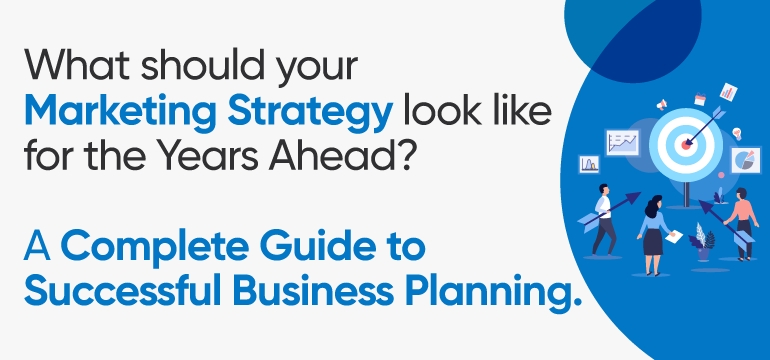While being in the middle of 2020 already, it’s time that we start planning for the next year, as to how we want our growth trajectory to be. If this may sound a little early, well, I must say that, strategic planning is never too early. It’s the best way to be ready for the year next and plan your resources and finances. Successful business planning entails the goal and objectives one has in mind, as well as the process of executing them.
In order to plan for the upcoming year, one must reflect on the past results. Like what really went well or something that didn’t turn out to be good. Reflecting on all these factors is imperative to plan. And in times of global crisis, strategic plans must shift from a bureaucratic process to a more targeted approach. Targets that are comparatively simple to achieve. This simplified approach happens to be more creative and analytical, which in turn helps a business in today’s dynamic environment.

Why does a Business need Strategic Planning?
To be honest, we plan for every trivial thing in our life. Be it a date or a late-night movie show, or a vacation. We, humans, are inclined towards planning for the future. Given that your business is an essential part of your life, it demands an extra mile of planning. A brand takes time to grow; brand value doesn’t get created within a month or a year. It is the continuous positive efforts that count.
- A Business gets Proactive, rather than Reactive
- A Befitting Direction is Achieved
- Operational Efficiency gets Multiplied
- Market Share and Profitability Increases Enormously
- A Business becomes much more Durable and Resilient
Simply put, strategic planning is nothing but a roadmap that alerts business owners for roadblocks, keeps them motivated and reduces stress. The more serious you are in working out the future goals, the higher is your chance to achieve your business’s long-term goals. Such is the major importance of strategic planning.
Competitive Advantage
Strategic planning also has an immense competitive advantage. Because while you define your goals beforehand with a robust plan to achieve them, you stay one notch up than your and competitors.
A business owner’s first priority should always be the marketing strategy he comes up with for the future. The goals, the objectives, the aspiration a business owner has – all of these have its influence on the successful sustenance of a business. You play the strategy game right, your business thrives.
We have compiled a few tried and tested practices of successful strategic business planning that can come in handy.

1. Start with your Company’s Vision Statement
Developing a vision statement for your business has crucial benefits. While chalking out the statement, you may come up with valid questions, such as where do you want to see your business five years down the line? To which direction is it headed? A vision statement defines the core reason for your business’s existence and builds an appropriate organizational culture.
This sets the stage for improved decision-making and focusing on the right target group. Having a vision statement also fosters long and short-term achievable goals and guides your business decisions along the way.
2. Conduct a Thorough Review.
Before thinking about the future, look back at the past. During the strategy-making process, your strategists must revisit your previous year’s business plan and how did it turn up. Whether all of the milestones have been achieved or left out.
By reviewing the performance of your team, you can take better informed-decisions pertaining to them. Review all the aspects right from the budget allocation to the program participation. Assess the things that went well. This performance review and assessment are pivotal in improving your next year’s marketing plan, as well as to repeat the success.
3. Identify your Business’s Core Competency
What is the strength of your business? Where does its weakness lie? Does the market trend project any opportunity for your niche? What kind of threats do you anticipate from your competitors?
All these questions guide a successful planning process. Taking an in-depth look into the various risks in the current and future market, makes your business emerge stronger than your peers. As well as minimizes identifiable risks. Encourage strategy dialogues between the management team and your strategists. These interactions can formulate an aligned strategic response based on industry analysis.
Thus, the more you know your business from the perspective of its SWOTs, the more you can build resilience and offset the risks of potential threats. Your business planning success mostly depends on this factor.
4. Develop your Personal Vision.
Each one of us has an expectation from what we do. Having a personal vision statement has a bigger significance than we think. A personal vision escalates one’s own self-awareness and gives a proper direction to one’s motives and desires. Through your own personal statement, you can know yourself better. It not only speeds up your decision-making, but also creates accountability for your actions.
Being accountable for what you do, what your business does, increases a sense of ownership. During a strategic planning process, it is common to get distracted, take detours, or go off the track. In such instances, personal vision can come handy. You may align your personal vision with your company vision statement and be at the forefront of decision making.
5. Maintain a Laser-Focused Approach
A laser-focus approach is one of the key tenets of successful business planning. Your focus cannot fall all over the place if you want to achieve something genuinely. Instead of focusing on several aspects and hoping to get results from all of them, it’s wise to narrow down your focus to smaller, yet, achievable goals. Whether it is about new customer acquisition, employee retention, or further expansion – your focus should be rock-solid. Be clear and concise as to what kind of results you want to see for your business.
If you can drill down to specific actions, your focus will be much narrow, ultimately leading you to achievable goals. Your CTAs, your marketing campaigns, marketing materials must work in perfect tandem to bring out the desired result.
6. Have an Eye for Short-Term Goals
Ever heard about SMART goals? No, we are not talking about smartness or intelligence. This concept is all about being Specific, Measurable, Actionable, Reasonable and Timely. That is exactly what your business goals should be. Create short-term goals around this concept and you can gauge how far you have succeeded. And how far you still have to go.
With each small goal achieved, you can set one more goal and thus work yourself forward. In each case, the extra efforts you put in, enable you to move further along your timeline – with a major boost in the morale.
Basically, short term goals are milestones in your complete journey to achieve the long term business goals. If your marketing strategy lacks short term goals, you are not giving enough clarity to yourself, of what you want to achieve.
7. Assess the Market, your Competitors and Future Trends for Real-time Analytics
This is one of the decisive stepping-stones to create a functional strategic planning for a successful year. Until and unless a business owner decides to assess the external forces influencing an industry, it is a tough job to come up with the required strategies. One needs to understand the competitive landscape and identify future market trends.
Because market trend is a dynamic process, where change is the only constant. Therefore, conducting a thorough external assessment during the strategic planning process is paramount.
8. Make or Break your Existing Ownership Structure for the Good
As your business grows, the previous ownership structure might not be as appropriate as it has been. The higher the range of your business, the more dated your earlier ownership hierarchy can seem. When ownership changes, the productivity and efficiency of majority-owned firms get improved.
Likewise, if needed, the owner might have to step down and dilute equity in the business. This way, the organization can get the required leadership to expand the business amidst a new business environment. Managing your ownership is a critical component of successful business planning.
9. Project your Financial and Staff Resources based on Real Data
First and foremost, marketing strategies must be based on realistic data and forecasts to generate steady cash flow for the upcoming year. The most crucial aspect of creating business strategies is to allocate the resources and budget for the daily running of the operations.
Assess the previous year’s financial statement and come up with resource allocation for the next year. So that you can mitigate any wastage and added expense. Moreover, if you depend on lenders for your fund, then it is obligatory to show them the real figures, and base your future projections on that.
10. Keep Strategic Execution your Top-most Priority
Often strategists make a blunder of giving less importance to strategy execution than it is required. They invest all of their time and effort in strategy development, rather than executing them.
And this results in 90% of organizations struggling to generate visible results intended by their marketing strategies. This clearly points out that a strategic plan must never be made in a vacuum without a team of strategic planners. Your marketing strategies must be developed with a clear intention of executing them until the end.

Conclusion
It goes without saying that a successful strategic business planning keeps an organization on the track and moves it towards greater coherence. Following these, you will be amazed to see how streamlined your business processes and operations have become. Although businesses sometimes have to take different routes based on the circumstances, the fundamental rules of strategic business planning must be the same.
Therefore, review and revise your year-long plan every month. Do not ever let it disappear once you are finished on the front end. Because newer and potentially profitable opportunities may emerge in the market, that need tactical changes in your plan.
The 10 best practices mentioned above can evolve your current planning process into a more tailored, aligned and execution-oriented process. Having the right tool, the right partner and an ideal strategy team can give you control over every aspect of your business. Being the business owner, you are the captain of your vessel who can steer way to the uncharted waters, full of success and much more!
